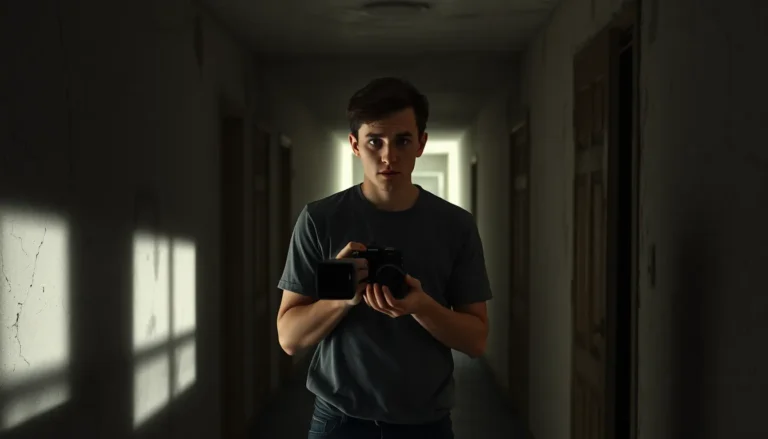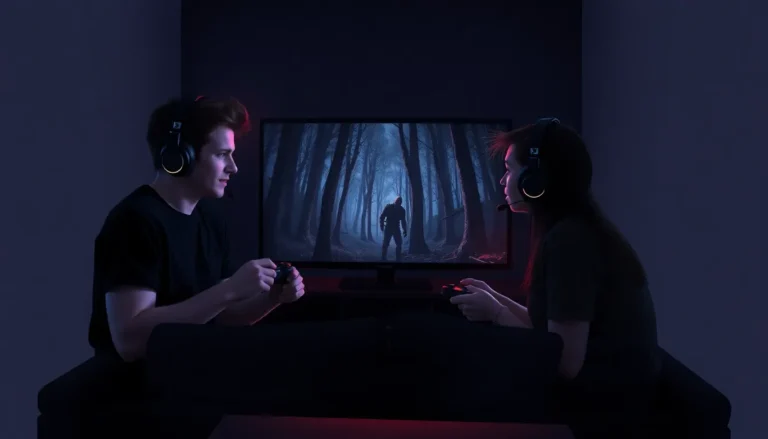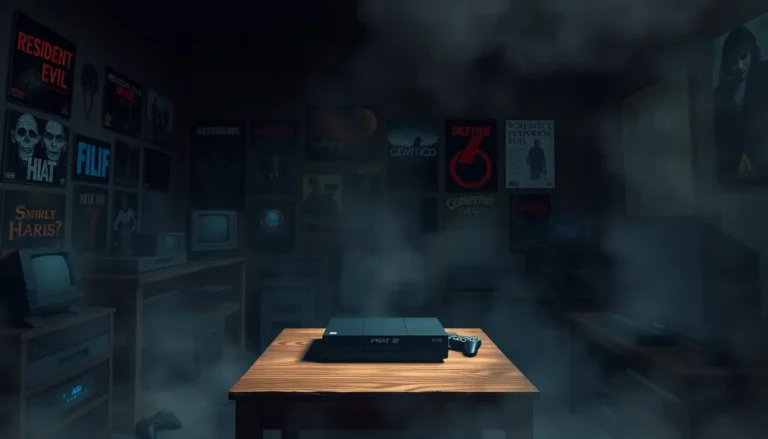In a world where jump scares and realistic graphics dominate the horror genre, pixel horror games emerge as a quirky yet spine-chilling alternative. These retro-styled games pack a punch with their charmingly simplistic visuals while delivering a chilling experience that keeps players on the edge of their seats. Who knew that a few blocky pixels could unleash such terror?
Pixel Horror Games
Pixel horror games offer a unique gameplay experience distinct from traditional horror video games. These titles utilize minimalist graphics and 8-bit aesthetics to evoke fear, enabling players to engage their imagination more than advanced visual technology does. Players often find themselves immersed in chilling narratives marked by unsettling atmospheres.
Numerous pixel horror games employ sound design effectively. Audio elements contribute significantly to the tension, often delivering haunting soundtracks and unexpected audio cues that heighten suspense. The combination of simplicity in visuals and complexity in audio fosters an engaging experience.
Many pixel horror games center on exploration, requiring players to navigate their environments carefully. Discovering hidden items and unraveling backstories creates a powerful sense of involvement. Game mechanics often include puzzles and challenges that enhance the atmosphere, making the gameplay more immersive.
Characters in these games frequently embody psychological themes. Developers often craft relatable protagonists and antagonists that draw players into the narrative. Common tropes include isolation, despair, and the human psyche’s fragility, all of which reinforce the horror elements.
Critically acclaimed titles in the pixel horror genre demonstrate its potential. Games like “Lone Survivor” and “Yomawari: Night Alone” exemplify how pixel art can deliver a gripping experience. They illustrate that storytelling, combined with visual style, plays a crucial role in pixel horror games’ success.
Overall, pixel horror games challenge the notion that high-end graphics dictate a game’s ability to frighten. Their creative use of art, sound, and narrative proves that gameplay can be just as thrilling with simpler designs, attracting a dedicated following among enthusiasts.
Key Features of Pixel Horror Games

Pixel horror games captivate players with unique features that stand out in the gaming landscape. Their distinct visual and auditory elements contribute significantly to the overall experience.
Visual Style and Aesthetics
Visual style in pixel horror games often embraces minimalist graphics. Such aesthetics tap into 8-bit designs to create an atmosphere of unease. Players engage more deeply with the narrative due to the simplicity of visuals, which allows them to fill in the gaps with their imagination. Bright colors can contrast sharply with darker themes, enhancing tension. Furthermore, pixel art draws on nostalgia, connecting players to classic gaming while crafting eerie scenarios. Classic titles like “Lone Survivor” demonstrate how effective this approach can be in establishing a haunting vibe.
Sound Design and Atmosphere
Sound design plays a crucial role in shaping the atmosphere of pixel horror games. Haunting soundtracks amplify feelings of dread while adding an emotional depth to gameplay. Unexpected audio cues can heighten tension, keeping players on edge. Ambient noises, from rustling leaves to distant whispers, contribute to immersion. Developers often focus on creating a soundscape that reflects the narrative’s psychological themes. The right sound can evoke memories or feelings, tying players into the experience fully. Games like “Yomawari: Night Alone” showcase how sound complements visual elements to create a truly chilling experience.
Notable Pixel Horror Games
Several pixel horror games stand out for their engaging narratives and immersive experiences. Each title brings a unique approach to the genre, combining minimalist aesthetics with psychological depth.
Lone Survivor
Lone Survivor captivates players with its haunting atmosphere and introspective storyline. Set in a post-apocalyptic world, the game requires players to navigate a desolate city inhabited by nightmarish creatures. Resource management becomes crucial, as players make choices about survival while battling their own sanity. The psychological horror elements intertwine with exploration, enhancing the tension throughout the experience. The engaging art style and eerie sound design amplify the unease, drawing players deeper into its chilling narrative.
Yomawari: Night Alone
Yomawari: Night Alone presents an exploration of childhood fears through its beautifully crafted, yet unsettling world. Set in a small town shrouded in darkness, players control a young girl searching for her missing sister. Each moment unravels the mysteries hidden within the locale, with numerous ghostly encounters that evoke feelings of dread. Combining charming pixel art with a rich soundscape, the game effectively creates an emotional connection to its protagonist. Players must solve puzzles and confront phantoms, making every decision impactful and deeply resonant.
Mad Father
Mad Father invites players into a creepy narrative involving a young girl and her enigmatic father, a scientist conducting disturbing experiments. The game’s 2D pixel art enhances its unsettling themes as players unravel dark secrets hidden within their family’s mansion. Each room offers puzzles and horrifying encounters, compelling players to explore further into the nightmarish world. The combination of eerie soundtracks and chilling visuals intensifies the horror experience, keeping players on edge. Through its engrossing storyline and distinctive style, Mad Father solidifies its place in the pixel horror genre.
The Appeal of Pixel Horror Games
Pixel horror games attract players by evoking fear through retro aesthetics and minimalist design. These simplistic visuals encourage players to rely on their imagination, often resulting in a more intense experience. Engaging sound design enhances the atmosphere, with haunting soundtracks and unexpected audio cues heightening tension.
Exploration serves as a core element, as players navigate eerie environments, uncover hidden items, and solve puzzles. Such gameplay deepens immersion and allows narratives to unfold naturally. Characters within these games resonate psychologically, often embodying themes of isolation and despair. Relatable protagonists and antagonists prompt players to reflect on the fragility of the human psyche.
Noteworthy titles such as “Lone Survivor” present a captivating post-apocalyptic world, intertwining resource management with psychological horror. Players are absorbed by its introspective storyline while navigating a haunting atmosphere. Alternatively, “Yomawari: Night Alone” immerses players in childhood fears, guiding them through unsettling landscapes in search of a missing sister. The emotional weight of this journey reinforces the game’s impact.
“Mad Father” also invites intrigue with its disturbing narrative involving a young girl and her cryptic father. Dark themes and unsettling revelations emerge as players explore the environment. Each title showcases how pixel horror games effectively combine minimalist visuals with profound psychological depth, thereby solidifying their appeal.
Bold graphics may dominate modern titles, yet pixel horror games demonstrate that simplicity can evoke just as much fear. Nostalgia for classic gaming influences the eerie scenarios, creating a unique charm. The diverse elements of narration, gameplay, and design contribute to a growing appreciation for this genre among enthusiasts.
Corners of Gaming
Pixel horror games have carved out a niche that resonates with both nostalgia and fear. Their minimalist graphics and immersive sound design create a unique atmosphere that draws players into chilling narratives. By emphasizing exploration and psychological themes, these games invite players to confront their deepest fears in ways that high-end graphics often can’t achieve.
As the genre continues to grow, titles like “Lone Survivor” and “Yomawari: Night Alone” showcase the power of storytelling combined with retro aesthetics. The simplicity of pixel art doesn’t diminish the horror; instead, it enhances the experience, proving that sometimes less truly is more. As players seek new thrills, pixel horror games will undoubtedly remain a compelling choice for those looking to explore the darker corners of gaming.





